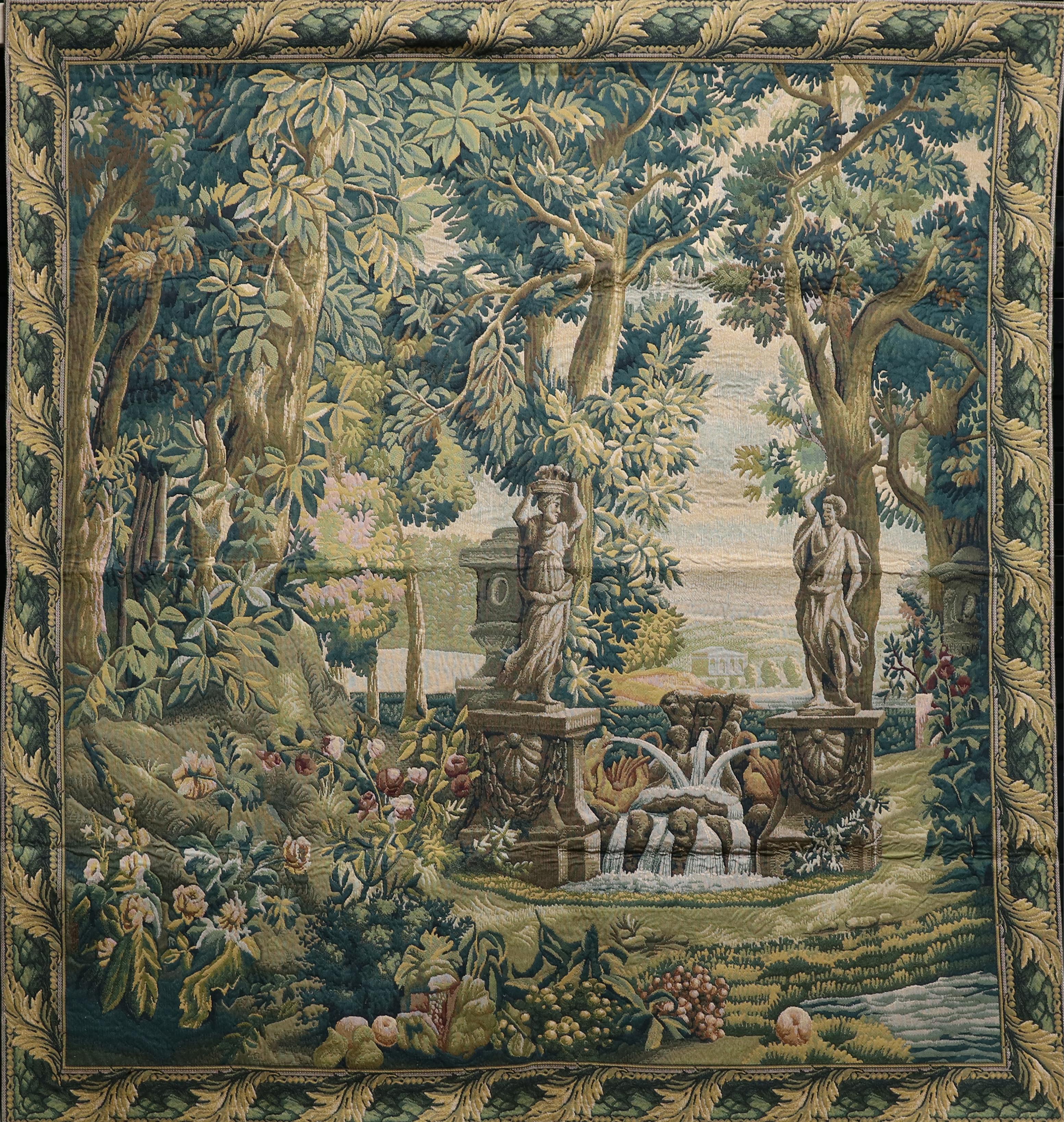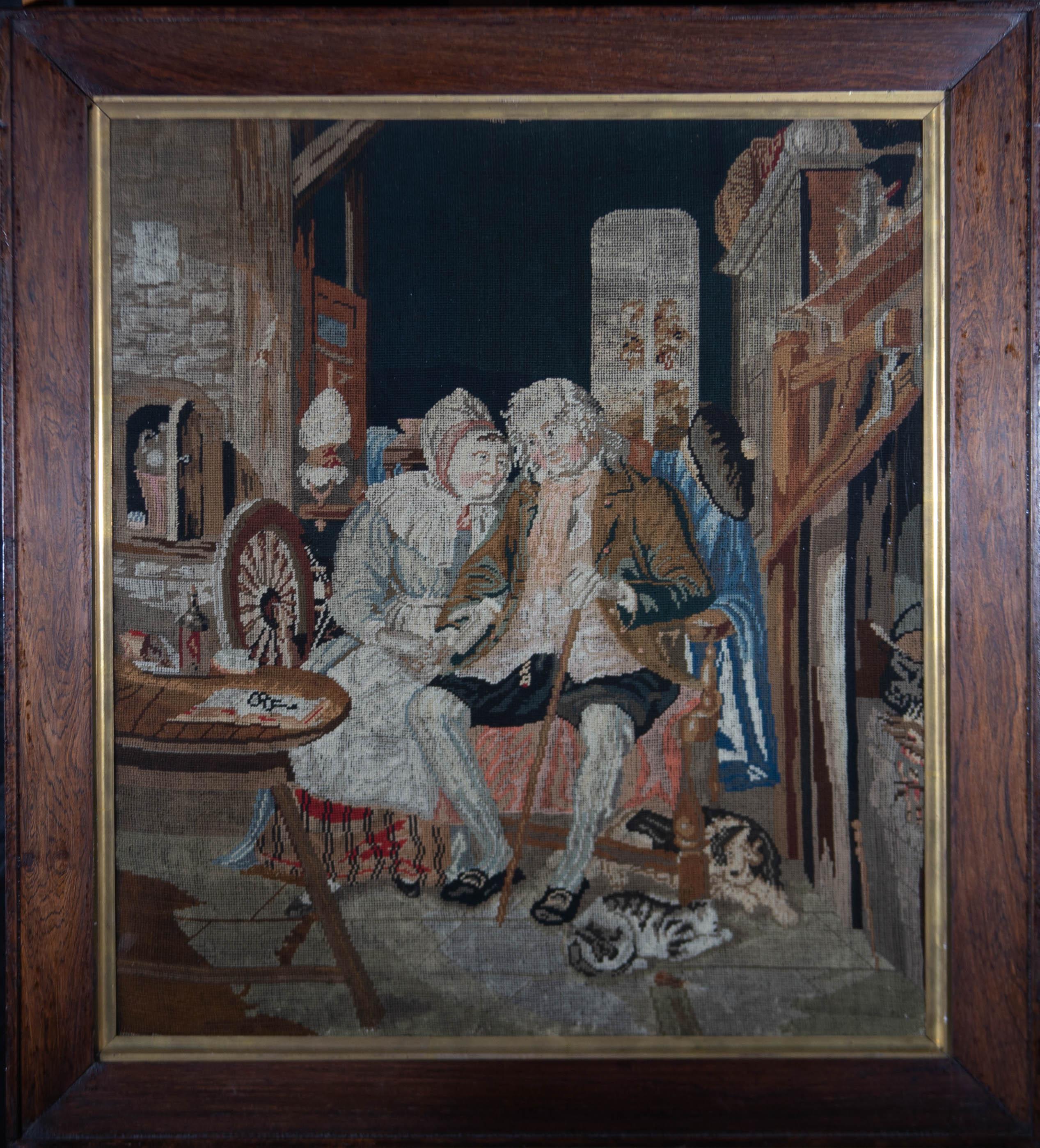Items Similar to Framed 20th Century Embroidery - Parrot Tulips & Petals
Want more images or videos?
Request additional images or videos from the seller
1 of 6
UnknownFramed 20th Century Embroidery - Parrot Tulips & PetalsUnknown
Unknown
About the Item
A vibrant floral & botanical embroidery depicting parrot tulips intertwined with red berries and smaller spring flowers. Presented in a stunning oak frame with carved detailing to the inner window. Unsigned. On linen.
- Creation Year:Unknown
- Dimensions:Height: 22.64 in (57.5 cm)Width: 19.69 in (50 cm)
- Medium:
- Period:
- Condition:In fine condition.
- Gallery Location:Corsham, GB
- Reference Number:
About the Seller
4.9
Platinum Seller
These expertly vetted sellers are 1stDibs' most experienced sellers and are rated highest by our customers.
Established in 2010
1stDibs seller since 2018
881 sales on 1stDibs
Typical response time: 4 hours
- ShippingRetrieving quote...Ships From: Corsham, United Kingdom
- Return PolicyA return for this item may be initiated within 30 days of delivery.
More From This SellerView All
- Late 19th Century Embroidery - A Timeless LoveLocated in Corsham, GBA charming petit point needlework from the late 19th Century, showing a heartwarming scene of an elderly couple sitting in a close embrace in their home with the cat and dog at their...Category
19th Century More Art
MaterialsTapestry
- 19th Century Embroidery - Flight into EgyptLocated in Corsham, GBA charming needlepoint picture depicting Mary And Joseph fleeing with the baby Christ to Egypt to escape King Herod. On cotton on stretchers .Category
19th Century More Art
MaterialsTapestry
- Early 20th Century Embroidery - Flowers and LeavesLocated in Corsham, GBA large work of embroidery depicting flowers and their leaves. Presented glazed in a wooden frame with twisted rope detailing and a gilt-effect inner edge. Unsigned.Category
20th Century More Art
MaterialsTapestry
- American Early 19th Century - Silkwork Picture with FiguresLocated in Corsham, GBRare American silkwork picture. Presented in a charming gilt-effect frame with glazing. On linen.Category
Early 19th Century More Art
MaterialsTapestry
- Late 19th Century Needlepoint - The Binding of IsaacLocated in Corsham, GBA needlepoint work depicting the Old Testament story of the Binding of Isaac. A messenger from God halts Abraham in the sacrifice of his son, causing ...Category
19th Century More Art
MaterialsTapestry
- Framed 19th Century Embroidery - Petit Point Embroidery and BeadworkLocated in Corsham, GBA fine survival, this original 19th Century petit point embroidery with extensive beadwork shows two figures surrounded by a scrolling foliate border. Well-presented in a deep gilt w...Category
19th Century More Art
MaterialsTapestry
You May Also Like
- The Villa GardenLocated in Atlanta, GALandscapes with trees, birds and rivers were popular tapestry subjects and often included architectural features and sculpture. Jacquard woven with relief stitch. It is fully lined...Category
20th Century Naturalistic More Art
MaterialsTapestry
- Porter Series: Carte L'Europe (Shower Woman)By William KentridgeLocated in Palm Desert, CA"Porter Series: Carte L'Europe (Shower Woman)" is a tapestry by South African artist William Kentridge. It is edition 1 of 5 (plus 2 APs) and signed verso "W. Kentridge". William Kentridge is a South African graphic artist, filmmaker, and theatre arts activist especially noted for a sequence of hand-drawn animated films he produced during the 1990s. The pungent humanism he revealed in these and other works echoed a larger European tradition of artists such as Honoré Daumier, Francisco de Goya, and William Hogarth. Kentridge, whose father was a noted antiapartheid lawyer, attended the University of Witwatersrand in Johannesburg (1973–76) and the now-defunct Johannesburg Art Foundation (1976–78). At various times in the 1970s and ’80s, he worked as an actor, playwright, set designer, and theatrical director, and he studied mime and theatre in Paris in the early 1980s. In 1992 he began an ongoing collaboration involving multimedia performances with Handspring Puppet Theatre (founded 1981) in Cape Town. As is clear from both his early training and his later artistic output, Kentridge’s interest in the visual arts was rooted in its connection with the theatrical arts. The narrative structure and character development in his films reflect this connection. While Kentridge pursued several avenues as an artist, at the centre of his work was a sequence of short animated films. To produce them, he made a rough charcoal drawing, photographed it, altered the drawing slightly, photographed it again, and so on. Kentridge’s original drawings are often completely effaced by their successors. Many of these films—including Johannesburg, 2nd Greatest City After Paris (1989) and Felix in Exile (1994)—follow the fortunes of the greedy capitalist Soho Eckstein and his alter ego, the sensitive and artistic Felix Teitelbaum. They present modern South Africa as reflective of the spiritual, ecological, and emotional crises of late capitalism. Kentridge later established himself as a consummate figure in the performing arts, particularly for his innovative stagings of the operas The Nose (2010) and Lulu (2015) at New York’s Metropolitan Opera and Wozzeck (2017) at the Salzburg Festival...Category
21st Century and Contemporary More Art
MaterialsTapestry, Silk
- Gobelin In Memory of My Mother, Rare Handmade Polish TapestryBy Aleksandra ManczakLocated in Surfside, FL57.5 inches x 57.5 inches Aleksandra Mañczak (born 1948) is an artist and teacher. From 1969 to 1974 she attended the Strzeminski Academy of Fine Arts and Design in Lodz, Poland. In 1974 she became an assistant at the Fiber-Art Studio and in 1983 she became the head of the same Fiber-Art Studio. In 1990 she became an assistant professor In 1995 she became a full professor (Professor of Art). From 1993 to 1996 she was the Deputy Rector for Science and Promotion at the Academy. Artistic Activity: photography, (since 2001 digital images), fiber-art, soft sculpture, paper-art assemblage, installation (including open-air), and writing about visual art, fiber-art and installation. She has had one-person shows in 1977, 1988, 1991, 1993, and every year since 1995. location: Lodz, Poland The year 1972 was also the time when Stefan Popławski’s (a graduate of Academy of Fine Arts in Poznań) piece was created. His simple Self-portrait is a very important interpretation, made in tapestry (162 x 90 cm), of a photograph from a family album. The artist frequently used famous documentary and historical pictures, as well as stills from the movies made by distinguished directors, and press photos. He transformed these selected “films of reality” into cycles: a series of photography reconstructions, movie “pictures,” old performances (Polish banners) and contemporary events. these works got the impact force of a monumentalized...Category
20th Century Modern More Art
MaterialsTapestry
- Hand Beaded Contemporary TapestryBy India BerglundLocated in Los Angeles, CAMaterial: Sustainably sourced satin, silk, glass beads, thread and sequins Dimensions: 34.5" x 28.5" The tapestry depicts three objects that would be thought of as mundane; a can of green tea, a pack of cigarettes...Category
2010s Contemporary Mixed Media
MaterialsTapestry, Thread
- Flowers, (After) Andy Warhol -Pop Art, Tapestry, Edition, Contemporary, DesignBy Andy WarholLocated in Zug, CH(After) Andy Warhol Flowers, 1968 Hand Woven Wool Tapestry 183 x 183 cm (72 x 72 in) Edition of 20 With the knotted name ‘ANDY WARHOL’ lower right and the embroidered annotation ‘WARHOL ©’ on the reverse Published by Modern Master Tapestries, NY Throughout art history, the flower and its symbolism have been a subject matter for many renowned artists. Andy Warhol explored the qualities of the flower image through his Pop Art prism in the Flower series of 1964, thus creating cartoon-like symbols that would be instantly recognized. The 1964 Flower series became one of his most iconic and successful works. Based on a discovered photograph of hibiscus blossoms, Warhol drenched the flowers’ floppy shapes with a variation of vibrant colors, transforming them into psychedelic indoor décor. Playing with traditional art historical themes, Andy Warhol gave a particular twist to this historically accepted symbol of life. The electric colors of his flowers, drawn from a darker and rich undergrowth background might be the indicator of an extreme vision of life, a life lived on the edge. Andy Warhol (1928-1987) was an American artist, a leading figure of the Pop Art movement. Using a variety of media materials from photographs up to computer-generated art, Warhol's works explore the relationship between artistic expression, celebrity, culture and advertisement that flourished by the 1960s. Emerging from the poverty and obscurity of an Eastern European immigrant family in Pittsburgh, Warhol became a charismatic magnet for bohemian New York. In 1960, he began to produce his first canvases depicting Popeye and Dick Tracy. After Marilyn Monroe’s death in August 1962, he started working from snapshots of the star’s already legendary face, which had been widely distributed by the world’s press. His choice of subjects clearly relates to an obsession with demise – his Marilyns, his Ten Lizies (created when the actress Elizabeth Taylor was seriously ill), and also his Elvis. Part of the “Death and Disaster” series, Andy Warhol´s...Category
20th Century Pop Art Figurative Prints
MaterialsTapestry, Wool
- Silver Marilyn, Andy Warhol, 1990's, Handmade Carpet, Pop ArtBy Andy WarholLocated in Zug, CHAndy Warhol (after) Silver Marilyn, 1990s Handmade Carpet 150 × 150 cm (59.1 × 59.1 in) Certificate of authenticity on label Edition of 20 In excellent condition Published by Modern Master Tapestries, NY The artwork is offered unframed As a golden legend of Hollywood, Marilyn Monroe held particular fascination for Andy Warhol. Her suicide on August 5, 1962 struck a personal chord and precipitated a commemorative series that isolated her beautiful and henceforth elusive visage against variously colored backdrops. In the increasingly secular 1960s, Warhol was quick to recognize that movie stars had replaced the religious figures of his childhood, as the idols which the population at large chose to worship. Andy Wahrol worked with tapestry in his life as works were presented by Charles Slatkin...Category
1990s Pop Art More Art
MaterialsTapestry
Recently Viewed
View AllMore Ways To Browse
Vintage Framing
Vibrant Floral
Small Vintage Framed Art
Floral Botanicals
Petal Art
Spring Flowers
Vintage Oak Frames
Embroidery Art
Flower Petal Art
Vintage Embroidery
Parrot Art
Vintage Parrots
Flower Embroidery
Vintage Embroidery Art
Framed Floral Tapestries
Floral Vintage Embroidery
Red Framed Botanical
Vintage Window With Flowers



